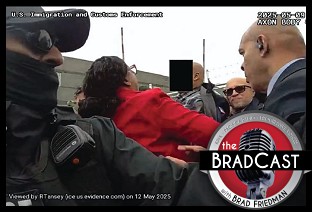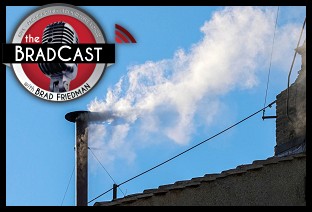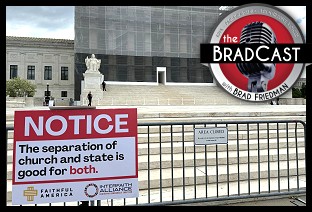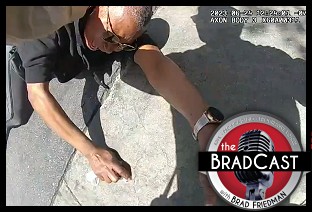READER COMMENTS ON
"Cuyahoga Co., Ohio Primary Was A Disaster"
(27 Responses so far...)
COMMENT #1 [Permalink]
...
Bluebear2
said on 7/21/2006 @ 11:06 pm PT...
Shaking head in amazement and disgust!
But then why am I surprised?
COMMENT #2 [Permalink]
...
Floridiot
said on 7/21/2006 @ 11:18 pm PT...
You know even though Vu kept his job, he's just Blackwells sock puppet... but the way I read it is Blackwell should be arrested for treason, it appears that he is the one directing Vu at every step, remember, even Bill Clinton said that Blackwell was on the executive board of a group (probably still does have full contact with it) that are experts at rigging elections, and that is the IRI, With the intent you show above, that should be enough to bring Fed charges against him, if there is any laws on the books about it
and if the FBI still works for us anymore (which I doubt), that should happen
COMMENT #3 [Permalink]
...
Dredd
said on 7/22/2006 @ 5:25 am PT...
Floridiot #2
You said:
if the FBI still works for us anymore (which I doubt)
They are actively and aggressively working against anything that would diminish the power of the republican dictatorship.
They are working for anything that will increase the power of the republican dictatorship.
And the republican dictatorship is a scurge upon the land, and is only getting worse and worse.
Meanwhile, in the Comfort Zone (a.k.a. western civilization), the only way to stay comfortable from conspiracy theories and inconvenient truth, is to be ignorant of what is going on.
And the voting rights movement keeps trying the same thing over and over decade after decade (link here, and here), and those who have subverted American democracy keep doing the same thing over and over.
And that system that keeps those "doin a heckuva job" in Iraq in power (link here) is doing the same thing in the Lebanon / Israel war (link here).
The blogosphere is going into celebrity mode, as is the government, like all this is some kind of soap opera with no real truth or consequences.
All this does not bode well for the future IMO.
COMMENT #4 [Permalink]
...
Arry
said on 7/22/2006 @ 7:31 am PT...
Dredd said, "Meanwhile, in the Comfort Zone (a.k.a. western civilization), the only way to stay comfortable from conspiracy theories and inconvenient truth, is to be ignorant of what is going on."
That includes supposedly dispassionate academics and experts in research methods. On another thread I spoke of "adjusting" exit poll methodology to better conform to election "results". It is not only a problem of the truly awful MSM, but professional pollsters are redesigning their polls - which have been tweaked for accuracy for decades and are now highly accurate - to reflect the results of the 2004 elections. In other words, poll results may be vitiated because pollsters refuse to entertain the one most likely explanation for the discrepancy between exit polls and election "results" - massive fraud.
But that's off topic, I guess. Well, are the citizens of Cuyahoga County up in arms and demanding the resignation of the two board members who voted to retain an election director who oversaw and was responsible for such an election disaster? Do they give a damn about their votes?
COMMENT #5 [Permalink]
...
Arry
said on 7/22/2006 @ 7:34 am PT...
Not to mention tarring and feathering Vu.
COMMENT #6 [Permalink]
...
Robert Lockwood Mills
said on 7/22/2006 @ 8:23 am PT...
I have a slightly different take on this. Blackwell is running for governor, and has been trying to take the focus off his own involvement in election fraud by claiming that local officials are in charge. Not me! I didn't disenfranchise anyone! I don't order election machines, the local guys do!
Now, Cuyahoga County blows up, and whose fault is it? Wu's! Which gets Blackwell off the hook, right? It shouldn't, of course...but we're talking about Ohio.
COMMENT #7 [Permalink]
...
Arry
said on 7/22/2006 @ 8:45 am PT...
COMMENT #8 [Permalink]
...
Robert Lockwood Mills
said on 7/22/2006 @ 9:51 am PT...
If Bernadette Noe divorced Tom Noe and married Bob Ney, then divorced him and married Yang Enterprises' spy Henry Nee, divorced him and married Ken Lay (assuming he's still alive), divorced him and married Tom DeLay, divorced him to marry Cuyahoga County Election Commissioner Vu, finally divorced him and married Bush lawyer John Yoo, her name would be Bernadette Noe Ney Nee Lay DeLay Vu Yoo.
But she'd still be miserable.
COMMENT #9 [Permalink]
...
Bluebear2
said on 7/22/2006 @ 10:08 am PT...
COMMENT #10 [Permalink]
...
Peg C
said on 7/22/2006 @ 10:29 am PT...
COMMENT #11 [Permalink]
...
NEOCONVICT
said on 7/22/2006 @ 3:44 pm PT...
The only good thing here is that it was actually reported on in the Cleveland Plain Dealer. We've come a long way from 2 years ago where we were screaming and the media was not listening. (sort of.) The problem remains, however, we have to get RID of the people who are causing these problems in the first place, and that is going to take some investigations and indictments and impeachments... which of course ain't gonna happen with a rigged voting system.
It does look rather bleak, doesn't it?
COMMENT #12 [Permalink]
...
deke slater
said on 7/22/2006 @ 5:06 pm PT...
As long as people mistake voting for real choice, nothing will change, no matter what apparatus we use.
COMMENT #13 [Permalink]
...
GWN
said on 7/22/2006 @ 9:44 pm PT...
Noe, Ney, Nee-vr, Noe,Ney, Nee-er Noe More RLM 
It'nice to space out now and then eh.
COMMENT #14 [Permalink]
...
Ram
said on 7/22/2006 @ 10:06 pm PT...
#4
Well, are the citizens of Cuyahoga County up in arms and demanding the resignation of the two board members who voted to retain an election director who oversaw and was responsible for such an election disaster? Do they give a damn about their votes?
With everything written in John's blog here, and everything that I have read about 2004 and this county, my image of the government of this county and state is as follows:
The "elected" and appointed officials are merely a group of thugs hell-bent on coercing power from the community. With their booty, they can eat at nice restaurants, dress in nice suits, and live in big houses.
The people in the community ooohhh and aaaahhh over these thugs' presence --hoping for a morsel in the form of a tip or a favor.
At election time, it seems like the voters fall into these categories:
Self-interest: "I can get the zoning passed for my strip club if I help keep this group of thugs in power," or "Keeping republicans in will get rid of the EPA so that I can continue to work at this cesspool and feed my family."
Too busy to know what's going on: "I've been working 12 hour shifts for years trying to stay ahead of foreclosure and take care of my sick mother so I don't have time to know what's really happening."
Delusional: "My brother, who works for Blackwell, says it's a fair system of democratic voting so I don't have to pay attention to the people who say otherwise."
Uneducated: "I dropped out in 8th grade because there was no future for me anyway --- so I missed the part about 'what it means to be a citizen'."
The 23%: John Dean's description of people who will follow authority no matter what the cost.
Defeatists: "I know there's election fraud, but what can I do? You can't fight city hall."
So that leaves very few people/voters/citizens to rise up to stop this mafia-like system that is strangling the community.
It will take the "enlightenment" that is scattered throughout the country and blogosphere to break up the "mob" family of Ohio. And we have to break it up. Its splinter groups are salted into the fabric of the entire US government (micro to macro).
The cold war used to be about stopping communism when it creeped into governments around the world --- stop it before it spreads.
The New Cold War for Americans is being fought against "Neoconism" --- a system of government growing a mafioso-style thuggery that suppresses us all into servitude. And the only weapons that we have are our keyboards and protests --- we just have to keep pounding. Fighting for Ohioans is fighting for us all.
COMMENT #15 [Permalink]
...
Robert Sawdey
said on 7/22/2006 @ 11:13 pm PT...
Plato said "We hang the small thieves, and elect the big ones to high office"... seems these problems persist even after 2400 years of acknowledging them... maybe we need to reverse the approach... elect small theives to office so they'll only take a LITTLE bit, not the TRILLIONS now missing... (sarcasm)
Obviously, part of the solution is outlawing blatently partisan oversight of elections with multi-party group oversight... and we need to outlaw corporate interferance... in MOST countries (like Canada, etc) corporations are forbidden any political expression - they can't VOTE, why should they be able to lobby? The political process is for VOTERS, ONLY! And ALL citizens should have a vote, and know it's COUNTED! One citizen, one vote... only and always!
COMMENT #16 [Permalink]
...
Agent99
said on 7/23/2006 @ 3:08 am PT...
#14 and #15
I'd like to say to you two fellas that I think your comments were particularly insightful. Thank you. Every drop of that stuff gives me energy.
COMMENT #17 [Permalink]
...
Larry Bergan
said on 7/23/2006 @ 4:29 am PT...
How did the cave men make it without corporations, food pyramids, and American soldiers to protect them?
COMMENT #18 [Permalink]
...
Ram
said on 7/23/2006 @ 6:48 am PT...
#16: You're welcome.
It's nice to know that someone reads my rants. I get so flustered and angry about the election fraud that I'm not sure I even make sense when I go on and on about how angry and flustered I really am about the Ohio "thingy".
:)
COMMENT #19 [Permalink]
...
Arry
said on 7/23/2006 @ 8:19 am PT...
I agree with Agent99 about #14 and #15.
Few people really want to be puppets to corporations and gangsters, but as long as the thugs control things they either want a piece of the action or don't want to think about it.
On the positive side, it's always been a limited group of informed and committed people who have spearheaded necessary change. Ram - I think your post is right on.
We should think about how we can influence each of the categories of people you mention as well as, of course, current non-voters (and recognize those who are hopeless cases.) The other concurrent option is to figure out how to get around them.
Our nation and the world cannot afford blind corruption on this scale anymore.
COMMENT #20 [Permalink]
...
Ram
said on 7/23/2006 @ 5:44 pm PT...
Deja Vu all over again. Another Robert Kennedy breaking up a "mob" that threatens to take over our country.
Sometimes obscured by the attention given other Kennedy-era episodes like the civil rights struggle or the missile crisis, Robert Kennedy's attack on organized crime, which, next to slavery may well have been America's worst social evil, at last gets the attention it deserves. In seeing the extraordinary power of the mob and its immunity from justice, Robert Kennedy was quite right in saying flatly, "Either we are going to be successful or they are going to have the country." We can be grateful Goldfarb has recorded the names and deeds of those like Walter Sheridan, Bob Blakey, Clark Mollenhoff and many others who joined Kennedy in this struggle against our own evil empire.
LINK
from Perfect Villains, Imperfect Heroes: Robert F. Kennedy's War Against Organized Crime. - book reviews
Washington Monthly, Dec, 1995 by Anthony R. Dolan
COMMENT #21 [Permalink]
...
Ram
said on 7/23/2006 @ 5:48 pm PT...
PS: Bobby jr and Brad, please be very very careful out there. We know what these people do to heroes.
COMMENT #22 [Permalink]
...
Larry Bergan
said on 7/24/2006 @ 2:12 am PT...
Ram #21
Amen to that. I saw a right wing idiot on C-SPAN today touting his book called, "Democrats, the party of death". I wondered if it might be about the Kennedys!
Good list of above, (#14), of why we can't get traction after years of trying!
COMMENT #23 [Permalink]
...
Dredd
said on 7/24/2006 @ 4:58 am PT...
RAM #14
The types of voters do not matter, it is the type of vote counter that really matters.
The electronic voting machine (EVM) watchdogs twenty years ago were saying what was said before the committee recently (1988 Article).
You can shock the hell out of the EVM audience with these quotes from a 1988 official report:
4.13 Summary Of Problem Types
4.13.1 Insufficient Pre-election Testing
4.13.2 Failure to Implement an Adequate Audit Trail
4.13.3 Failure to Provide for a Partial Manual Recount
4.13.4 Inadequate Ballots or Ballot-Reader Operation
4.13.5 Inadequate Security and Management Control
4.13.6 Inadequate Contingency Planning
4.13.7 Inadequate System Acceptance Procedures
...
Concern had been heightened by a series of articles published in the summer of 1985 in the New York Times. The articles cited statements by two computer experts reporting that a computer program widely used for vote-tallying was vulnerable to tampering. Several elections were identified in which losing candidates claimed that it would be possible to fraudulently alter the computer programs that were used in their contests.
(NIST Report 1988, bold added).
No one mentioned that twenty years is enough to have more than "suggested rules" which are admittedly inadequate ... which election war lords are ignoring anyway.
And who asked why one person certifies the machines no matter how many ITA companies claim to do the certification? Or who sets the standards of the lone ranger doing the testing (The Lone Tester)?
Doesn't it appear that either the voting rights movement related to the EVM world has failed ... or congress has failed ... or perhaps both?
COMMENT #24 [Permalink]
...
Ram
said on 7/24/2006 @ 7:23 am PT...
#23
I agree that in normal, rational human beings in a sterile environment that those quotes would shock the hell out of an audience --- shock them enough to make them act. However, there is this sentence that keeps popping up over and over again in the entire western world that allows people to ignore a problem and go back to their daily lives:
"It can't happen here"
I first noticed this sentence when living in another country. It shocked me because it seemed so stupid.
The scenario is something like:
An American documentary shows how a poison got into cattle feed and produced cancers in humans through the food chain. The reaction is an immediate press release to the citizens of that country; "do not be afraid, it can't happen here". Everyone breathes a huge sigh of relief and proceeds to feel good about their "luck" in living in such a great country. In the meantime, I would hear stories of strange cancers affecting people living in certain areas of the country and I would wonder.
I heard this sentence over and over again for many different issues. It was almost like a code for "It is happening here --- but you've got better things to do so run along now."
This was quite an eye-opening experience for me. So when I hear philosophers in the U.S. say that "fascism can't happen here because we have too many checks and balances", the hair stands up on the back of my neck. (Thank god for John Dean who is brave enough to warn us that it CAN happen here!)
Back in the USA, I hear the comment over and over again: "It can't happen here."
I heard the comment locally. I live in Mesa, AZ where there are the electronic tally machines. I've been told and read over and over again that these machines are unhackable. About 7 years ago, I was at "election central" when the ballots and machines were coming back for the final tally.
I was struck by a peculiar event. Almost the entire city's ballots had been tallied; it was late in the evening. Some of the officials were beginning to panic because one precinct had not come in. There were hours between the last two precincts --- what was taking so long?
The car finally pulled up with a group of people in it who began unloading the trunk. When they were asked where they had been, they said that they had stopped at a restaurant to eat first. (Knowing that the whole city was waiting for the results, these people stopped to eat? They couldn't have waited another 1/2 hour for food? Or grabbed takeout?)
What added to the suspicion was that some of the issues on the ballot had been very close --- until the very end.
No one challenged or questioned the circumstances --- because these machines are "unhackable" and no one wanted to deal with the problem that would arise if it was brought into question.
The local news was only there until the 10:00 broadcast was over. So there was no media coverage of the latecomers.
Since this was before the election fraud issue took off on the internet, I had no idea what could be done to screw up the tallies. All I had was a prickly feeling on the back of my neck with the words "It can't happen here" flashing out a warning in my mind.
(Note: For all I know, it could have been a completely legitimate election.)
You only have to look at how the press and the public respond to Mikel Haas in San Diego to see that the phrase works on the general public.
Q. Can that happen here?
A. No.
Q. Okay. That's all I wanted to know. See ya.
This is why I believe so strongly in what Brad and others are doing --- showing how "it CAN happen here" in places all over the country.
These efforts defuse the scariest assurance in the English language:
"It can't happen here."
COMMENT #25 [Permalink]
...
Dredd
said on 7/24/2006 @ 8:43 am PT...
RAM #24
My statement which you focused on was:
You can shock the hell out of the EVM audience
The EVM audience is not the general public.
The EVM audience is people like you and I ... who think this is the first EVM movement, and who are giddy about clearing this thing up with protest in all its various forms.
They have a form of "it can't happen here" which takes "we have the power to stop it".
Many of them vote for those doing the stealing, without knowing it.
They try to sanitize the problem by trying to make a "non-partisan" or "bi-partisan" issue out of it.
It is not a voting issue, it is a criminal issue.
Why the hell would anyone, unless they have the "it can't happen here" mentality, make a political movement out of a criminal enterprise?
"It isn't criminal, it is a bi-partisan or non-partisan political issue" is the whole underlying approach.
This is the approach the thieves have pumped out and which the voting rights movement has swallowed.
My post #23 shows that this approach has not changed anything over the past 20 years, and only elitist delusion will continue down that path another 20 years.
The type of voter (repub, dem, indy, green, libertarian, etc), as I said in post #23, has no bearing on the issue. It is the type of criminal that we should focus on.
Criminal prosecution is the only thing that will change it. Bi-partisan and/or non-partisan prosecution.
Meanwhile everyone is trying to become a voting rights hero and everyone is demanding one, while the prosecutors and election warlords the thieves have put in place chuckle to themselves about it.
COMMENT #26 [Permalink]
...
Ram
said on 7/24/2006 @ 9:36 am PT...
#25 Dredd:
I think I know what you're saying.
Criminal prosecution is the only thing that will change it. Bi-partisan and/or non-partisan prosecution.
It's like how Lou Dobbs gets angry that congress wants to pass new immigration legislation when there is no intention (or funding) to enforce it --- just as has been done for the past 20 years with the old legislation.
Passing laws --- with no intention of enforcing them or having loopholes that freight trains can fit through-- is just one more opportunity for the criminals to say "see it can't happen here --- we have laws" (enter Haas).
In fact, when I hear of more legislation to do with election reform, I get nervous. After all, the HAV act was what gave all the communities the money to buy machines that could be used to "fix" the election instead of "fixing" the problem.
That's why I can't wait to see what happens with RFK jr's lawsuit.
I really appreciate that you took the time and effort to make and explain your point, Dredd. It makes a lot of sense to prosecute.
But, at the same time, isn't there a lack of laws where the machines are concerned?
So when you ask me about Ohio, you can recite to me the worst data that anyone has unearthed in Ohio, I would have to say to you — very technically — so what? What does it violate?
It may violate your sensibilities, it may violate my sensitivities, it may violate someone else’s sense of fair play. But the Secretary of State of Ohio has proven that you can get straight through an election by saying: We broke no law. You see the problem?
--Rev. DeForest Soaries
So what now?
COMMENT #27 [Permalink]
...
czaragorn
said on 7/25/2006 @ 6:41 am PT...
RLM #8 - I wonder what her maiden name was - it would give us an extra nee, and wouldn't it be delicious if the name were Boubou, or something!


 'Dangerous Times': Climate Scientist Warns Trump 'Censorship' Endangering Nat'l Security: 'BradCast' 5/21/25
'Dangerous Times': Climate Scientist Warns Trump 'Censorship' Endangering Nat'l Security: 'BradCast' 5/21/25 And Then They Came for Members of Congress...: 'BradCast' 5/20/25
And Then They Came for Members of Congress...: 'BradCast' 5/20/25 'Green News Report' 5/20/25
'Green News Report' 5/20/25
 Appeals Court Blocks Last Route for Voters to Challenge Violations of the VRA: 'BradCast' 5/19/25
Appeals Court Blocks Last Route for Voters to Challenge Violations of the VRA: 'BradCast' 5/19/25 Sunday 'Now Hoarding' Toons
Sunday 'Now Hoarding' Toons Mad World:
Mad World: 'Green News Report' 5/15/25
'Green News Report' 5/15/25 Plane Corruption and the Future of the DOJ: 'BradCast' 5/14/25
Plane Corruption and the Future of the DOJ: 'BradCast' 5/14/25 'Deeply Evil': GOP Proposes Largest Medicaid Cuts in History: 'BradCast' 5/13/25
'Deeply Evil': GOP Proposes Largest Medicaid Cuts in History: 'BradCast' 5/13/25 'Green News Report' 5/13/25
'Green News Report' 5/13/25 And Then They Came for the Mayors...: 'BradCast' 5/12/25
And Then They Came for the Mayors...: 'BradCast' 5/12/25 Sunday 'New Guy, Old Guy' Toons
Sunday 'New Guy, Old Guy' Toons Blowing Smoke. At the Vatican and White House: 'BradCast' 5/8/25
Blowing Smoke. At the Vatican and White House: 'BradCast' 5/8/25 'Green News Report' 5/8/25
'Green News Report' 5/8/25 SCOTUS Weighs Public Funding of Religious Schools: 'BradCast' 5/7/25
SCOTUS Weighs Public Funding of Religious Schools: 'BradCast' 5/7/25 Trump Judge Blocks NC GOP Theft of 2024 Supreme Court Seat: 'BradCast' 5/6/25
Trump Judge Blocks NC GOP Theft of 2024 Supreme Court Seat: 'BradCast' 5/6/25 Prosecutors Quit After U.S Attny Strikes Deal With Felon Cop: 'BradCast' 5/5/25
Prosecutors Quit After U.S Attny Strikes Deal With Felon Cop: 'BradCast' 5/5/25 Trump Losing Streak Continues into SECOND Hundred Days: 'BradCast' 5/1/25
Trump Losing Streak Continues into SECOND Hundred Days: 'BradCast' 5/1/25 100 Daze (w/ Digby and Driftglass): 'BradCast' 4/30/25
100 Daze (w/ Digby and Driftglass): 'BradCast' 4/30/25 Campaign to 'Impeach Trump Again' Gains Fresh Momentum: 'BradCast' 4/29/25
Campaign to 'Impeach Trump Again' Gains Fresh Momentum: 'BradCast' 4/29/25 And Then They Came for the Judges...: 'BradCast' 4/28/25
And Then They Came for the Judges...: 'BradCast' 4/28/25 Trump EPA Guts Enviro Justice Office: 'BradCast' 4/24/25
Trump EPA Guts Enviro Justice Office: 'BradCast' 4/24/25
 VA GOP VOTER REG FRAUDSTER OFF HOOK
VA GOP VOTER REG FRAUDSTER OFF HOOK Criminal GOP Voter Registration Fraud Probe Expanding in VA
Criminal GOP Voter Registration Fraud Probe Expanding in VA DOJ PROBE SOUGHT AFTER VA ARREST
DOJ PROBE SOUGHT AFTER VA ARREST Arrest in VA: GOP Voter Reg Scandal Widens
Arrest in VA: GOP Voter Reg Scandal Widens ALL TOGETHER: ROVE, SPROUL, KOCHS, RNC
ALL TOGETHER: ROVE, SPROUL, KOCHS, RNC LATimes: RNC's 'Fired' Sproul Working for Repubs in 'as Many as 30 States'
LATimes: RNC's 'Fired' Sproul Working for Repubs in 'as Many as 30 States' 'Fired' Sproul Group 'Cloned', Still Working for Republicans in At Least 10 States
'Fired' Sproul Group 'Cloned', Still Working for Republicans in At Least 10 States FINALLY: FOX ON GOP REG FRAUD SCANDAL
FINALLY: FOX ON GOP REG FRAUD SCANDAL COLORADO FOLLOWS FLORIDA WITH GOP CRIMINAL INVESTIGATION
COLORADO FOLLOWS FLORIDA WITH GOP CRIMINAL INVESTIGATION CRIMINAL PROBE LAUNCHED INTO GOP VOTER REGISTRATION FRAUD SCANDAL IN FL
CRIMINAL PROBE LAUNCHED INTO GOP VOTER REGISTRATION FRAUD SCANDAL IN FL Brad Breaks PA Photo ID & GOP Registration Fraud Scandal News on Hartmann TV
Brad Breaks PA Photo ID & GOP Registration Fraud Scandal News on Hartmann TV  CAUGHT ON TAPE: COORDINATED NATIONWIDE GOP VOTER REG SCAM
CAUGHT ON TAPE: COORDINATED NATIONWIDE GOP VOTER REG SCAM CRIMINAL ELECTION FRAUD COMPLAINT FILED AGAINST GOP 'FRAUD' FIRM
CRIMINAL ELECTION FRAUD COMPLAINT FILED AGAINST GOP 'FRAUD' FIRM RICK SCOTT GETS ROLLED IN GOP REGISTRATION FRAUD SCANDAL
RICK SCOTT GETS ROLLED IN GOP REGISTRATION FRAUD SCANDAL VIDEO: Brad Breaks GOP Reg Fraud Scandal on Hartmann TV
VIDEO: Brad Breaks GOP Reg Fraud Scandal on Hartmann TV RNC FIRES NATIONAL VOTER REGISTRATION FIRM FOR FRAUD
RNC FIRES NATIONAL VOTER REGISTRATION FIRM FOR FRAUD EXCLUSIVE: Intvw w/ FL Official Who First Discovered GOP Reg Fraud
EXCLUSIVE: Intvw w/ FL Official Who First Discovered GOP Reg Fraud GOP REGISTRATION FRAUD FOUND IN FL
GOP REGISTRATION FRAUD FOUND IN FL

































